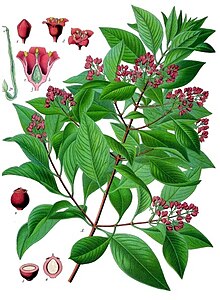| Santalum album | |
|---|---|

| |
| Scientific classification | |
| Kingdom: | Plantae |
| Clade: | Tracheophytes |
| Clade: | Angiosperms |
| Clade: | Eudicots |
| Order: | Santalales |
| Family: | Santalaceae |
| Genus: | Santalum |
| Species: | S. album
|
| Binomial name | |
| Santalum album | |

Santalum album is a small tropical tree, and the traditional source of sandalwood oil. It is native to Indonesia (Java and the Lesser Sunda Islands), the Philippines, and Western Australia.[2] It is commonly known as the true sandalwood, white sandalwood, or Indian sandalwood. It was one of the plants exploited by Austronesian arboriculture and it was introduced by Austronesian sailors to East Asia, Mainland Southeast Asia and South Asia during the ancient spice trade, becoming naturalized in South India by at least 1300 BCE.[3] It was greatly valued for its fragrance, and is considered sacred in some religions like Hinduism. The high value of the species has caused over-exploitation, to the point where the wild population is vulnerable to extinction. Indian sandalwood still commands high prices for its essential oil owing to its high alpha santalol content, but the lack of sizable trees has essentially eliminated its former use for fine woodworking. The plant is long-lived, but harvest is only viable after many years.
- ^ Arunkumar, A.N.; Dhyani, A.; Joshi, G. (2019). "Santalum album". IUCN Red List of Threatened Species. 2019: e.T31852A2807668. doi:10.2305/IUCN.UK.2019-1.RLTS.T31852A2807668.en. Retrieved 12 November 2021.
- ^ "Santalum album L." Plants of the World Online. Royal Botanic Gardens Kew. Retrieved 19 June 2024.
- ^ Fuller, Dorian Q.; Boivin, Nicole; Castillo, Cristina Cobo; Hoogervorst, Tom; Allaby, Robin G. (2015). "The archaeobiology of Indian Ocean translocations: Current outlines of cultural exchanges by proto-historic seafarers". In Tripati, Sila (ed.). Maritime Contacts of the Past: Deciphering Connections Amongst Communities. Delhi: Kaveri Books. pp. 1–23. ISBN 9788192624433.
